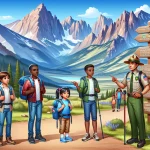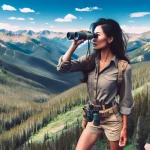Colorado boasts over 24 million acres of public lands, offering a vast playground for backcountry enthusiasts. With its diverse terrain and stunning natural beauty, Colorado’s backcountry provides endless opportunities for adventure. However, exploring these remote areas requires careful planning, appropriate gear, and a strong understanding of safety precautions.
In This Article
TL;DR
- Colorado's backcountry features a wide range of terrain, from rugged mountains to lush forests and alpine lakes.
- Safety and preparedness are crucial when venturing into the backcountry, and they must include proper gear, navigation skills, and wilderness first aid knowledge.
- Seasonal weather patterns greatly impact backcountry conditions and accessibility.
Understanding the Terrain and Climate of Colorado’s Backcountry
The Geographic Diversity of Colorado
Colorado is home to numerous mountain ranges, each with its own unique characteristics. The Rocky Mountains dominate the state, with notable subranges like the Front Range, Sawatch Range, and San Juan Mountains. These ranges offer a variety of landscapes, from towering peaks and deep canyons to expansive meadows and dense forests.
Seasonal Weather Patterns and Their Effects
Colorado’s weather can be unpredictable, especially in the backcountry. Summer brings warm temperatures and afternoon thunderstorms, while winter sees heavy snowfall and frigid conditions. Spring and fall offer milder weather but can also be prone to sudden changes. Understanding these seasonal patterns is essential for planning your backcountry adventures and packing appropriate gear. When snow is on the ground, be sure to check with the Colorado Avalanche Information Center for forecasts relating to avalanche and mountain weather conditions.
Planning Your Backcountry Adventure
Essential Gear and Supplies
When exploring Colorado’s backcountry, having the right equipment is crucial. Essential items include:
- Sturdy hiking boots or trail running shoes
- Layered clothing for varying weather conditions
- Backpack with ample storage and support
- Tent, sleeping bag, and sleeping pad for overnight trips
- Water filtration system and plenty of water
- Food and cooking supplies
- First aid kit and emergency shelter
- Navigation tools, such as a map, compass, and GPS device
Safety and Wilderness First Aid
Familiarizing yourself with basic wilderness first aid is essential when venturing into remote areas. Consider taking a wilderness first aid course to learn how to handle common injuries and illnesses like altitude sickness. Always carry a well-stocked first aid kit and know how to use its contents. In case of emergencies, carry a reliable communication device, such as a satellite messenger or personal locator beacon.
Navigating Colorado’s Backcountry Trails
Trail Etiquette and Conservation
When exploring Colorado’s backcountry, it’s important to practice Leave No Trace principles to minimize your impact on the environment. This includes:
- Packing out all trash and waste
- Staying on designated hiking trails to avoid damaging vegetation
- Respecting wildlife by observing from a safe distance
- Minimizing campfire impact by using established fire rings or camping stoves
Popular Trails and Hidden Gems
Colorado offers a wide range of backcountry trails suitable for various skill levels. Some popular options include:
- Four Pass Loop in the Maroon Bells-Snowmass Wilderness
- Chicago Basin in the San Juan Mountains
- Lost Creek Wilderness Loop near Denver
- Mount Zirkel Wilderness in northern Colorado
- Hidden Valley near Estes Park
For experienced explorers seeking lesser-known areas, consider researching more remote regions like the Flat Tops Wilderness or the Raggeds Wilderness.
Engaging in Backcountry Activities
Hiking and Backpacking
When selecting a trail for hiking or backpacking, consider your experience level and physical fitness. Colorado offers a range of hiking trails, from easy nature walks to strenuous multi-day backpacking trips. Always research trail conditions, obtain necessary permits, and pack appropriate gear for the duration of your trip.
Climbing and Mountaineering
Colorado is a premier destination for rock climbing and mountaineering. Popular spots include:
- Eldorado Canyon State Park near Boulder
- Black Canyon of the Gunnison National Park
- Rocky Mountain National Park
- San Juan Mountains in southwestern Colorado
- Winter Park
When engaging in climbing or mountaineering, always prioritize safety. Hire a qualified guide if you lack experience, and always check weather conditions and climb within your skill level. Training and guides are available through organizations like Colorado Mountain School or the Colorado Mountain Club.
Experiencing Backcountry Huts and Yurts
The Hut System in Colorado
Colorado is home to an extensive network of backcountry huts and yurts, offering a unique way to experience the wilderness. The 10th Mountain Division Hut Association manages a system of 34 huts connected by 350 miles of trails. Other notable hut systems include the San Juan Huts and the Never Summer Nordic yurts.
Staying in Backcountry Huts
Backcountry huts provide a rustic yet comfortable base camp for your adventures. Most huts are equipped with basic amenities like bunks, propane stoves, and outhouses. Some huts require you to bring your own sleeping bag and pad, while others provide bedding. Be sure to book your hut well in advance, as they are popular and can fill up quickly.
Wildlife and Natural Features
Encountering Wildlife
Colorado’s backcountry is home to diverse wildlife, including elk, deer, moose, black bears, and mountain lions. When encountering wildlife, always maintain a safe distance and never feed or approach animals. Make noise while hiking to avoid startling wildlife, and properly store food to prevent attracting bears to your campsite.
Unique Natural Landscapes
Colorado’s backcountry is filled with stunning natural features, from towering peaks and deep canyons to serene alpine lakes and cascading waterfalls. Some notable geological formations include:
- Garden of the Gods near Colorado Springs
- Black Canyon of the Gunnison National Park
- Great Sand Dunes National Park and Preserve
- Hanging Lake in Glenwood Canyon
For a refreshing dip or a scenic picnic spot, seek out some of Colorado’s pristine alpine lakes, such as Maroon Lake, Emerald Lake, or Ice Lake.
FAQ
How do I choose the right trail for my skill level?
Consider factors like elevation gain, distance, and terrain when selecting a trail. Beginner-friendly trails generally have lower elevation gains and well-maintained paths. As your experience grows, you can gradually tackle more challenging routes. Always research trail conditions and consult with local rangers or outdoor shops for recommendations tailored to your skill level.
What are the most essential items to pack for a backcountry trip?
Proper footwear, layered clothing, a reliable backpack, shelter (tent or hammock), sleeping gear, a water filtration system, food and cooking supplies, a first aid kit, emergency shelter, and navigation tools are the most essential items for a backcountry trip. Always pack for the specific conditions you’ll encounter and the duration of your trip. A backcountry skier is rewarded with a level of peace and solitude not often found in busy resorts, but they also have to make additional preparations.
How can I stay safe while exploring the backcountry?
To stay safe in the backcountry, always tell someone your plans and expected return time, especially when solo hiking. Carry a reliable communication device for emergencies. Stay on designated trails, pack appropriate gear, and know your limits. Be prepared for sudden weather changes and know how to navigate with a map and compass. Familiarize yourself with basic wilderness first aid and carry a well-stocked first aid kit.
Are there any permits or fees required for backcountry exploration in Colorado?
Permit requirements vary depending on the area you plan to explore. Many wilderness areas and national parks require permits for overnight camping, and some popular trails may have daily entry limits. Always research the specific regulations for your destination and obtain any necessary permits well in advance. Some areas may also require parking fees or recreation passes.
What are the best times of year for backcountry exploration in Colorado?
The best times for backcountry exploration in Colorado depend on your desired activities and weather preferences. Summer (June-August) offers warm temperatures and access to high-elevation trails, but afternoon thunderstorms are common. Fall (September-October) brings stunning foliage and milder weather. Winter (November-March) is ideal for snowshoeing and backcountry skiing, while spring (April-May) can be muddy but offers early access to some trails.






